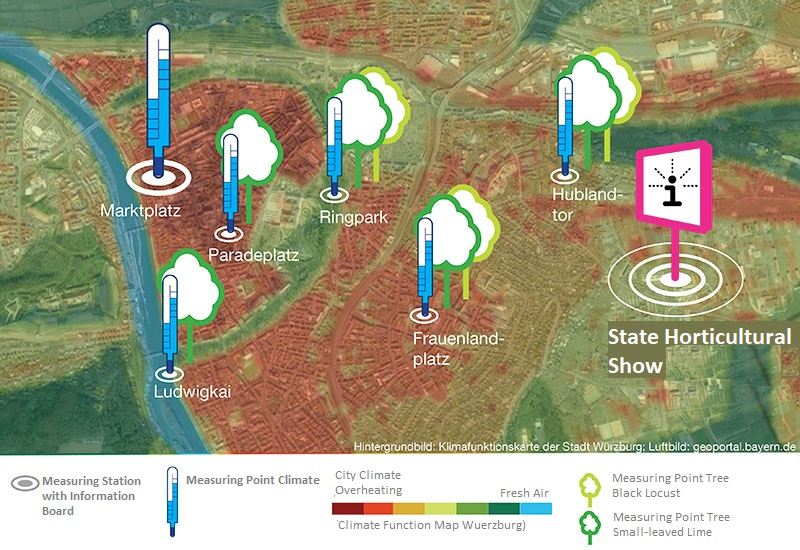Wuerzburg Climate Experience 2016 (KEW)

Cities are characterized by a specific climate compared to their rural surroundings. Particularly on hot days, the temperature in a city can rise tremendously compared to its vicinity. This effect, called the ‘urban heat island’ (UHI) effect, depends on the location within the city, on the building structure and on the degree of sealing vs. greening. Especially cities like Wuerzburg which are set in a heat basin with densely built-up areas and less urban greenery are heavily affected.
The research is set in the city of Wuerzburg, located in Lower Franconia, a region which will suffer severely from climate change, with more heat waves and drought periods. In the future, the number of heat days and tropical nights with temperatures > 20°C will increase sharply in the city center, drastically decreasing the quality of life.
Urban green, especially trees, can positively influence the micro-climate of an area. Their crowns can provide shade, and their leaves transpire water and thus lower air temperature. Additionally, the root base of trees can store rainwater.
Based on several sites within the city of Wuerzburg, this project aims at examining the way the climate of urban sites differs depending upon the degree of tree cover and urban structure, as well as the degree to which urban trees and the microclimate influence one another. In this way, the relevance of trees for urban planning can be demonstrated.
Within the scope of the state horticultural exhibition in 2018, seven climate/tree research stations will be established in the city of Wuerzburg. Over a period of three years, measurements on the site climate, tree growth and the environmental performance of the trees are to be measured, processed and graphically presented. The aim is to sensitise the public to the topic of urban climate and urban greenery and to enable them to experience applied research live.
In detail the following topics will be addressed:
How will the climate of the greater area of Würzburg change?
How do current extreme weather events differ from past centuries?
Which urban site types are most affected by climate changes?
Which climate characteristics are obvious in the urban area of Würzburg at a small scale?
Which influence do different urban site types have on the climate there?
Which influence do urban trees have on the site climate?
Which influence does the specific site climate have on the growth and transpiration of urban trees?
Do species-specific differences occur?
Which site-climatic variable influences the growth and transpiration of urban trees the most?
Which consequences arise under future climate conditions?
How much can urban trees contribute to climate protection (CO2-storage, cooling of buildings) and climate adaption (thermal convenience outdoor, rainwater management)?
For which urban site type can trees contribute the most to climate adaption?
What influence does the site climate and the micro-climate of urban trees have on the living quality in urban areas?
Which of the studied urban tree species is most suitable for small scale climate regulation in cities?
How can the performance of urban trees and the small scale characteristics of the urban climate be communicated to the broad public?
How can the importance of urban trees for the urban climate be given as much importance as possible in the public discussion on future urban development?
How can chances and risks of climate change implications be communicated to the broad public?